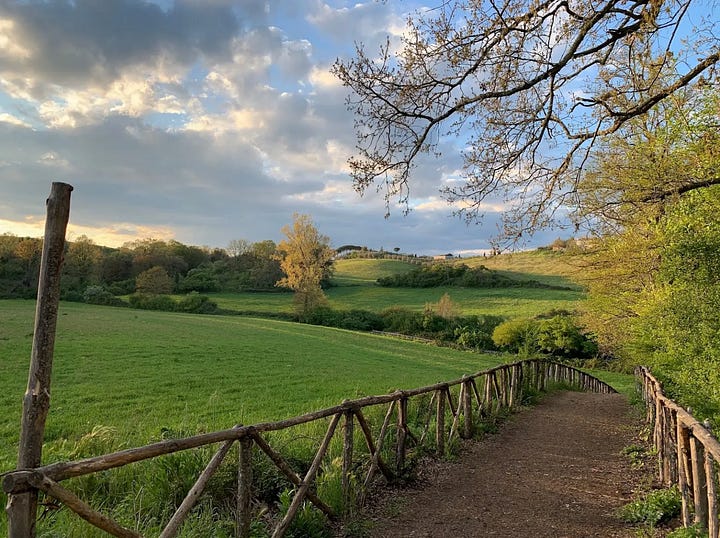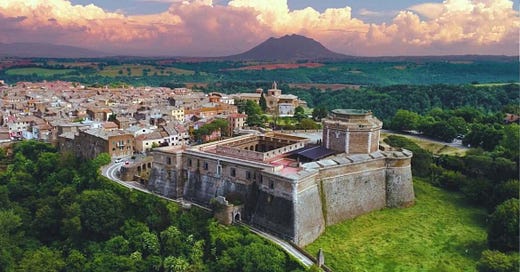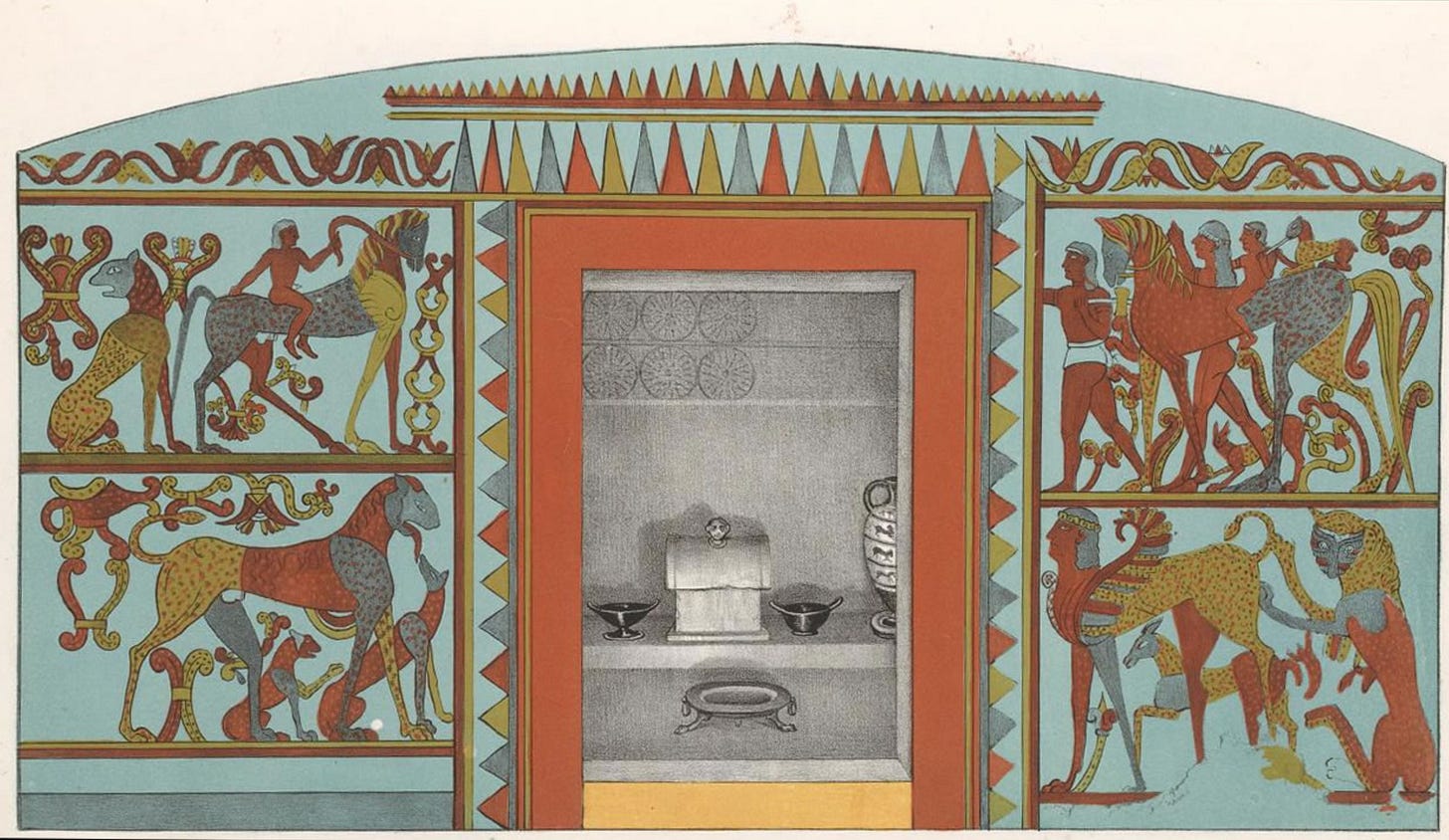Before we dive into the possibilities of Veii, I’d like to make you aware of something noticed by Higgins that I included in The Holy Sailors (click the image). He wrote, “Three places near Rome are clearly proved by inscriptions to have been the site of this celebrated town. Has God multiplied the ruins of cities for the amusement of antiquarians, as the author was told in Italy, that he has multiplied the heads of dead saints for the edification of the faithful?”
It might be that none of the locations claiming to be Veii are the ancient city, so keep that in mind as we try to make sense of it. The following is The Ponte Sodo at Veii, an artificially enlarged tunnel, what Grant called a characteristic masterpiece of Etruscan hydraulic engineering, which channelled the Fosso Valchetta (River Cremera) through a rocky outcrop so as to prevent flooding and assist irrigation. Italy, indeed, was the Garden of Europe: Paradise.


According to Wiki, the Tomb of the Roaring Lions is an archaeological site at the ancient city of Veii, Italy. It is best known for its well-preserved fresco paintings of four feline-like creatures, believed by archaeologists to depict lions. The tomb is believed to be one of the oldest painted tombs in the western Mediterranean, dating back to 690 BCE.
The tomb was discovered in 2006, after a tombarolo (illegal excavator) propositioned an Italian court. He was on trial for trafficking hundreds of illegally excavated antiquities. In exchange for a more lenient sentence the tombarolo offered to lead authorities to a previously undiscovered tomb. The court agreed to the unusual offer and the tombarolo lead them to the necropolis of Grotta where previous Etruscan archaeological sites had been unearthed. However, the tombarolo led them to a unique site where the Tomb of the Roaring Lions was discovered.
The Tomb of the Ducks (Tomba delle Anatre) is claimed to be the oldest painted grave in Etruria so far. It is named so after these five ducks. However, of the following, the only one that seems to be correctly colored is the third photo with the woman in it. This location is an opportunity for others to bring to light through modern photography.
There may be some use of old color symbolism involved, with the red symbolizing the fire and the yellow symbolizing the light and heat from the fire.
I wonder if the five ducks are even ducks. What if they’re another type of fowl? Could they be a precursor to the stigmata?
The following is an artistic rendering of the Campana tomb. Grant wrote that it appeared to belong to the end of the seventh century (BC). He acknowledges the wall-paintings being reminiscent of eastern rather than Greek models, which, if authentic, would support my suspicion that the Etruscans were connected to Egypt and the orient on account of their Phoenician ancestors.
This gentleman supports my suspicion that archaeological forgery occurred at this location, or at the very least, it’s been robbed to the point of not being able showcase the Truth about it.
I reached out to the Michele Damiani regarding the authenticity of this tomb, and here is his response accompanied by the following video, “I think that the structure of the tombs is original, the paintings perhaps not, also because today they have practically disappeared and are therefore impossible to study. All that is known I have made available to this friend, flipped prof, who has made a virtual reconstruction of it.”
What would my suspicions indicate? They would support everything that people like Bishop Thirwall have claimed, that the Phoenicians civilized the Greeks, not the other way around. The ancient Italians are descendants of the Phoenicians, not the Greeks. Their connection to Ancient Egypt may be a result of them civilizing North Africa long before the Indian variety of people made their way there. This would explain the lack of eastern art and hieroglyphics on the old megalithic structures.
It is my opinion that the following account is part of a mythological story, however, I will include it for reference because it describes Veii being equivalent to Athens. According to Dionysius of Halicarnassus (II, 54), “The third war Romulus engaged in was against the most powerful city of the Tyrrhenian race at that time, called Veii, distant from Rome about a hundred stades; it is situated on a high and craggy rock and is as large as Athens. The Veientes made the taking of Fidenae the pretext for this war, and sending ambassadors, they bade the Romans withdraw their garrison from that city and restore to its original possessors the territory they had taken from them and were now occupying. And when their demand was not heeded, they took the field with a great army and established their camp in a conspicuous place near Fidenae.”
The mixing of mythology with history has led to an erroneous chronology of Italy being colonized by Greeks rather than being an indigenous people who, in all likelihood, begot the Phoenicians, whose travels and success in civilization brought the wealthiest people from all over the world to Italy, much like America. This erroneous chronology has led people to believe the Greeks are an older civilization than the Etruscans and other native Italians, which has disrupted the progress of historians. People will object to this, but I remind you that Etrusco-Phoenician is not Indo-European (if that’s even a real thing; we know Proto-Indo-European is a nonsense construct). I suspect what people claim is Proto-Indo-European is a result of ancient Italian conquest in Asia. Almost all of the religious symbolism, language, and the phenotypes of the inhabitants suggest this. Had the Britons looked more like Indians or Asians, I may not have been so confident in this conclusion.
Grant wrote about a Veientine sculptor named Vulca, whose work was in demand at Rome, but makes no mention of his name being Vulcan. I know people take names based on mythology. My family is no different. I’m named after a Welsh god. But when there isn’t much to go on and every detail of something’s history corresponds to mythology, it is a red flag.
Become a member to access the rest of this article.
Keep reading with a 7-day free trial
Subscribe to Ancient History, Mythology, & Epic Fantasy to keep reading this post and get 7 days of free access to the full post archives.










